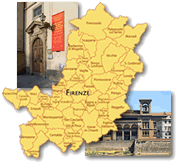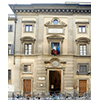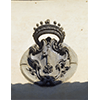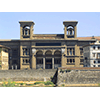Florence - Historical Libraries

A tour through the historical libraries of Florence is not only aimed at getting to know one of the most important book patrimonies of Italy. Indeed, the complexes that house these centuries-old institutions also constitute a unique system enabling the visitor to become acquainted with the evolution of the concept of the place consecrated to reading, from the first examples in the Renaissance, by means of criteria of a rigorous geometric harmony.
[Given the limitations on traffic in the historical centre, we advise you undertake the proposed itinerary on foot]
The Biblioteca di San Marco, the oldest library in Florence, is the ideal point of departure of this itinerary. Since the second half of the 15th century, the carefully lighted interiors, originally with green plaster on the walls in order to rest the eyes and facilitate reading, housed a rich library which also included rare scientific texts.
The Convent of San Marco owes its present appearance to the reconstruction of an earlier Medieval convent performed by the architect Michelozzo under commission to Cosimo the Elder, between 1436 and 1446. Three years after becoming state property in 1866, it became headquarters of a Museum housing many masterpieces, including the world-famous fresco cycle by Beato Angelico and most of his works on wood.
Though principally important from the historical-artistic viewpoint, the Museum also presents numerous elements of scientific interest: among the works by Angelico, it is only proper to cite the paintings conserved in the Pilgrims’ Hospice which portray the two physician saints, Cosma and Damiano, who are easily recognisable by their cassocks, red hats and the round box containing medicines. Exemplary among these is the painting on wood of the "Healing of the Deacon Justinian", in which the two saints are depicted in the act of transplanting the leg of a "moor" in replacement of the deacon’s diseased leg. Extremely interesting for the geographic disciplines is instead the San Marco Altarpiece, realised between 1438 and 1440: here, the Christ Child holds a terrestrial globe that modern scholars of ancient cartography have interpreted as a reference to the then known dry lands.
On the right wall of the passageway that connects the cloister of Sant’Antonino with the stairway that leads to the upper floor, the visitor can observe a cycle of four paintings by Jacopo Vignali, realised on the occasion of the plague of 1622-23 and intended for the convent "Spicery" (pharmacy). These paintings portray the theme of the disease and care of the body and spirit. On the opposite wall is the "Miracle of Saint Paul", a seventeenth-century work by Giovanni Bilivert, which presents an interesting curiosity: resting on the nose of one of the secondary figures is, in fact, a pair of eyeglasses, an object already widespread in the 16th century, and usually depicted in works of art as a symbol of knowledge and science.
The tie with science is even stronger, however, on the upper floor of the convent where, in addition to the cell of Cosimo with the fresco of the Adoration of the Magi in which there is a figure holding an armillary sphere, we also find the monumental Library by Michelozzo. The first public library of the Renaissance, it was born to conserve the books of humanist Niccolò Niccoli which were joined, by order of Cosimo the Elder, by the major texts of Medieval theological, legal and scientific knowledge. In the following centuries, the importance of the library, continually enriched with new volumes, was testified by mathematician and philosopher Gottfried Wilhelm von Leibniz who, in 1689, was able to consult a text of mathematical logic (the Liber calculationum by Richard Swineshead), which he had sought elsewhere in vain. The remains of a wind-rose, carved on a layer of plaster at the height of the library’s seventh western bay, indicate the former location of the collection of scientific books, which is also testified by a sixteenth-century catalogue of the convent’s works.
The San Marco complex is also tied to an episode that directly involved Galileo Galilei. In 1615, the Dominican Niccolò Lorini in fact denounced Galilei to the Inquisition, sending a copy of a letter in which the Pisan mathematician defended the validity of the Copernican theories. The Fathers of San Marco accused Galileo of having formulated «dubious or impudent» affirmations.
(Elena Fani)
Around the corner on Via Cavour, the visitor runs into the Baroque facade of the Biblioteca Marucelliana. The main reading room is very interesting and entirely lined with eighteenth-century boiseries, displaying precious volumes to great effect.

Established at the initiative of Francesco Marucelli as a public library for the less affluent citizens, it opened to the public on September 18, 1752, on the same premises it occupies today. In 1783 the collection of drawings and prints was inaugurated. The Library’s wealth of books was considerably increased subsequent to the suppression of the ecclesiastical bodies, between the 18th century and the early years of the 19th. Other important sources were added during the first years of the Kingdom of Italy. Since 1910, thanks to the law instituting the compulsory deposit of printed materials, the works printed in the Province of Florence are deposited here. Today the Library possesses an imposing heritage made up of over 500,000 volumes (including incunabula and sixteenth-century editions), manuscripts and unbound papers (autograph works and correspondence of literary, historic, artistic and scientific interest), periodicals and opera libretti, in addition to an important collection of prints and drawings (15th to 19th centuries). Noteworthy among the autograph works are the papers of Francesco Redi, Giacinto Cestoni and some of the letters of Antonio Vallisneri.
The Library also contains the "Luigi Beuf" Italian Cryptogamic Herbarium. The Herbarium consists of a collection of dried cryptogams (around 3,000 samples) glued to removable sheets. This work, kept in the Manuscripts and Rare Items Room, was produced in thirty instalments by the Luigi Beuf European Library of Genoa, between 1858 and 1867.
Especially important from the scientific viewpoint is a pair of globes (celestial and terrestrial) from 1699, the work of the Venetian cosmographer Vincenzo Coronelli, purchased from the Bandini Library in 1755.
(Anna Toscano)
Continuing along Via Cavour and turning right at the corner with Via de’ Gori, you come to Piazza San Lorenzo, dominated by the mass of the basilica built by Brunelleschi. On the side of the church, between the first cloister and the holy building, is the entrance to the Biblioteca Medicea Laurenziana, the vestibule of which was designed by Michelangelo. In addition to its interest for the exceptional book patrimony it houses, including rare manuscripts of a scientific nature, the library is also noteworthy for the furnishings of the main hall which still conserves the original wooden pluteus.
In 1524 Clement VII had ordered Michelangelo to design and construct a building in which to place the Medicean library, purchased by Leo X and kept by the Dominicans on the premises of the Church of San Marco. In 1558 the building destined to house the Medici Laurentian Library, inserted in the monumental complex of the Church of San Lorenzo, was completed. The Library was opened to the public for the first time in 1571.
The Library contains precious works also as regards scientific topics. In 1491 Agnolo Poliziano wrote to Lorenzo the Magnificent, who had requested him to search for important scientific manuscripts, that he had found in the library of Giorgio Valla "some books by Archimedes... that are lacking to us". Of those manuscripts, known as Codex A, Lorenzo had a copy made, which is conserved today in the Laurentian Library and which constitutes the most important example of the Archimedean Corpus, Valla’s original having been lost. During those same years Giovanni Lascaris, again at the request of Lorenzo, found in Greece the precious collection of ancient medical texts, including the writings of Hippocrates, that had belonged to the Byzantine physician Niceta, today included among the Library’s collections. The library also possesses the Greek and Latin codices and manuscripts of the Camaldoli Monastery and the Naturalis Historia by Pliny purchased by Cosimo the Elder at Lubeck, which constitutes the first complete codex of the important naturalist encyclopaedia, later translated by Landino.
(Anna Toscano)
On Via de’ Ginori, very close to Piazza San Lorenzo, you will find the entrance to the Biblioteca Riccardiana, housed in the fifteenth-century Palazzo Medici-Riccardi and equipped with quite an unusual and complex system of wooden shelves, carved and gilded in the 18th century.

Established by the Riccardi family in 1600, the library has been located since 1670 in the Medicean palace on Via Larga, today's Via Cavour, which was sold in that year by the grand-ducal family to the Riccardi. Opened to the public in 1715, enlarged by precious material of humanist nature dating from the 16th century, it became the property first of the State of Tuscany and then of Italy in the early 19th century. For the collection of humanist codexes, autograph texts of scientists and men of letters and for the incunabula kept here, the Riccardian Library was considered almost an appendix of the Laurentian Library, whose administration it shared for many years. Becoming independent in 1942, it was associated with the Morenian Library, established by the scholar Domenico Moreni, thus enlarging the Riccardian's wealth of books dealing with the history, literature and archaeology of Tuscany.
Among the volumes of high scientific and cultural value possessed by the Library is a copy of Pliny's Historia naturalis dating from the 10th century, an edition of Robert Dudley's Arcano del Mare dedicated to Ferdinand II de' Medici and various autograph texts by Pico della Mirandola, Leon Battista Alberti and Agnolo Poliziano.
(Anna Toscano)
Walking back down Via de' Ginori, take Borgo San Lorenzo toward Piazza San Giovanni, then Via dei Calzaioli, Via della Ninna, via dei Neri and Corso dei Tintori into Piazza Cavalleggeri, where you will see the monumental eclectic facade of the Biblioteca Nazionale Centrale di Firenze, one of the principal institutions of its kind in Italy.

The Library originated from the book holding of Antonio Magliabechi, consisting of some 30,000 volumes and bequeathed to the city of Florence in 1714. In 1737, the grand-ducal administration established that the works published in Florence should be deposited there, and in 1743, the rule was extended to all works published in Tuscany. The Library opened to the public in 1747. In 1774, it was assigned part of the library of physician Antonio Cocchi. Considerable increments arrived following the suppression of church foundations. In 1861, it was united with the Palatine Library, formed by Grand Duke Ferdinand III of Lorraine. In 1885, it took the name of National Library and, in 1875, appellative of Central. In 1870, it was given printing rights on national territory. Originally housed in the Palazzo della Dogana, adjoining the Uffizi, the Library was transferred to its present, specially built headquarters in 1935. The 1966 flood caused serious damage: part of the holding was either lost or damaged. Following the event, the Centre for Book Restoration was instituted, and is still active today. The Library publishes the Bibliografia Nazionale Italiana, and is the pilot headquarters for the institution of the National Library Service.
Its manuscripts of scientific interest include the precious Galilean collection and the Targioni Tozzetti holding. The main nucleus of the Galilean collection, born of the obstinate commitment that Vincenzo Viviani put into conserving and recovering it, and later the property of Giovanni Battista Clemente de’ Nelli, was purchased by Ferdinand III in 1818. Further increased with other Galilean manuscripts from libraries, archives and private collections, it was first ordered by the Grand Duke himself. Reordered by Vincenzo Antinori, the Collection consisting of 348 volumes is divided into five sections: the first gathers documents that belonged to Vincenzo Galilei; the second comprises manuscripts by Galileo Galilei; the third section contains several documents by the scientist’s contemporaries; the fourth conserves codices by Benedetto Castelli, Bonaventura Cavalieri, Evangelista Torricelli and Vincenzo Viviani, while the fifth contains the papers that belonged to the Accademia del Cimento. An appendix follows, containing papers and documents of Galilean interest, donated to the library by Antonio Favaro, curator of the national edition of the works of Galileo Galilei.
The Targioni Tozzetti holding comprises manuscripts that at different times became part of the National Library patrimony. The first nucleus was purchased for the Palatine Library by Grand Duke Leopold II in 1851. The second nucleus, consisting of manuscripts by Giovanni, Ottaviano and Antonio Targioni Tozzetti, and the papers of Pier Antonio Micheli, including the Micheli-Targioni herbal, was sold to the National Library in 1894. The miscellanea of the Targioni library and the printed works of the Tozzettis’ were purchased by the Magliabechi Library in 1857. The entire collection comprises texts of botany, mineralogy, biology, geology, chemistry, agriculture and medicine, along with literary pamphlets, travelogues and autographs of illustrious personages.
The Library preserves eighteenth, nineteenth-century collections of dried plants from the manuscript holdings of the religious corporations suppressed between the 18th and 19th centuries. It also presents a pair of globes (celestial and terrestrial), made by Venetian cosmographer Vincenzo Coronelli in 1696 and dedicated to William III of Orange, King of England.
Emblems of science are also found outside of the Library. On one of the turrets of the facade (on the viewer’s right) is the statue of Galileo Galilei holding up his telescope. Also on the facade is a series of medallions dedicated to famous personages. Among them, Leonardo da Vinci and, again, Galileo.
(Anna Toscano)
****************************
Texts by Elena Fani
English translation by Victor Beard
Last update 08/ott/2008



 = libraries and archives
= libraries and archives  = scientific research centers
= scientific research centers  = memorial places of scientists
= memorial places of scientists = public health places
= public health places = places of science and worship
= places of science and worship = places of technology
= places of technology  = museums and collections
= museums and collections  = villas and gardens of science
= villas and gardens of science

